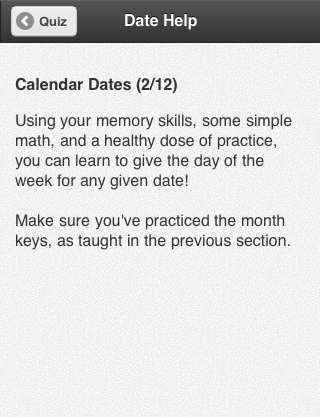 When I posted my Day for any Date Online Toolbox, a commenter named Jay notified about a method of getting the year key that was new to me, known by the rather bizarre name of "Odd + 11".
When I posted my Day for any Date Online Toolbox, a commenter named Jay notified about a method of getting the year key that was new to me, known by the rather bizarre name of "Odd + 11".
I recently ran across it again in the Scientific American article, What Day Is Doomsday? How to Mentally Calculate the Day of the Week for Any Date, so I figured it was time to give it a closer look.
The standard mathematical formula for finding the year key is as follows:
In my Day for any Date Online Toolbox post, I give a more detail explanation of this formula. While doing mod 7 (also explained at the same link under "Modular Arithmetic") isn't difficult, the rest of the formula isn't that easy to work through in your head.
This is where the Odd + 11 method shines. It give the same year key as the above formula, but is far easier to calculate mentally. So what exactly is this method? Here are the steps:
1. Let T be the year's last two digits.
2. If T is odd, add 11.
3. Let T = T/2.
4. If T is odd, add 11.
5. T = (T mod 7).
6. T = 7 - T.
Adding by 11 is easy, especially if you add 10 first, then add 1. For example, 74 + 11 = 74 + 10 + 1 = 84 + 1 = 85. Even 99 + 11 is easy: 99 + 11 = 99 + 10 + 1 = 109 + 1 = 110. Notice that this approach eliminates the need for any carrying!
Let's try this approach, and say the last two digits of the year are 76:
1. T = 76.
2. T isn't odd, so T = 76.
3. T = 76 / 2 = 38.
4. T isn't odd, so T = 38.
5. T = (38 mod 7) = (38 - 35) = 3.
7. T = 7 - 3 = 4.
If you scroll down to the table of years on this page, you will note that 2076 does indeed have a year key of 4.
Let's try the formula again, but with 63, so that we can see the effects of adding 11. when needed, to the total:
1. T = 63.
2. T is odd, so T = 63 + 11 = 74.
3. T = 74 / 2 = 37.
4. T is odd, so T = 37 + 11 = 48.
5. T = (48 mod 7) = 48 - 42 = 6.
6. T = 7 - 6 = 1.
Sure enough, when checking the year table, the year key for 63 is a 1! Notice, too, that the 63 example is a worst-case scenario, in which you had to add 11 both times. Even Odd + 11's worst case scenario isn't that hard to work through!
As I mention on that same page, taking the time and trouble to memorize the year keys for all years 00 through 99 will get you the key number in the quickest manner. However, if you don't want to put in that time and effort, the Odd + 11 method is easy and can get you the year key very quickly.
Also in the Day for any Date Online Toolbox post, I discuss the 28-year pattern. Within the same century (for our purposes, this means in the same set of years from 00 through 99), any two years that are exactly 28, 56, or 84 years apart will have the same key number. Knowing this, you can make your Odd + 11 calculations even easier!
Let's try taking advantage of this when given a year ending in 82. Before going through the standard process, we realize that we can reduce the 82 itself by subtracting 56 (it's too small to subtract 84, of course). So we figure 82 - 56 = 82 - 50 - 6 = 32 - 6 = 26. So, we'll start with T = 26 instead:
1. T = 26.
2. T isn't odd, so T = 26.
3. T = 26 / 2 = 13.
4. T is odd, so T = 13 + 11 = 24.
5. T = (24 mod 7) = (24 - 21) = 3.
6. T = 7 - 3 = 4.
Check the tables again, and you see that 82 does have a key year of 4, as does 26! Now you see how the 28-year pattern allows you to work with smaller numbers, yet achieve exactly the same results!
Even though I didn't run across it until earlier this year, I like it because of the ease it brings to the mental calculation of what is usually the most difficult part for most people.
Update (Oct. 31, 2011): As near as I can tell, the Odd + 11 method came from a paper by Chamberlain Fong and Michael K. Walters, titled Methods for Accelerating Conway's Doomsday Algorithm (part 2) (PDF).


 (NOTE:
(NOTE: 









 Quick, name any city, state, or country! Before you look up the population of that geographic area, what would you guess is the leftmost digit of that number?
Quick, name any city, state, or country! Before you look up the population of that geographic area, what would you guess is the leftmost digit of that number?
 It's one thing to learn how to perform amazing mental feats, but it can also be very instructive to watch how others present their mental abilities.
It's one thing to learn how to perform amazing mental feats, but it can also be very instructive to watch how others present their mental abilities.

